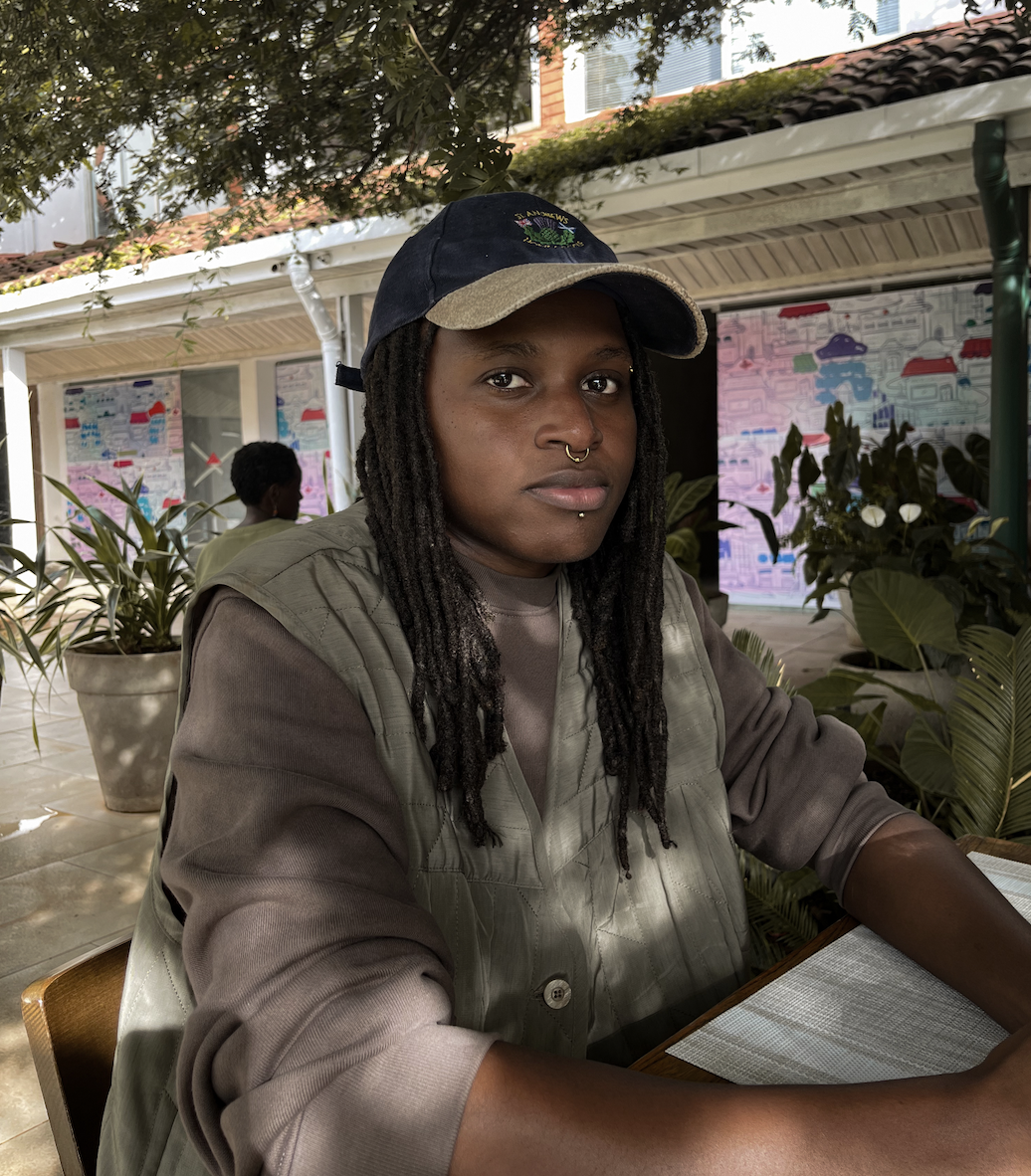Akumu is a versatile visual creative specializing in illustration, graphic design, and animation. Her distinctive style blends surrealism, hand-drawn and digital techniques, and typographic elements with themes of humor, dreams, escapism, and rebellion. With a background in Visual Communication and industrial design, coupled with experience as a graphic designer and illustrator, she brings a rich skill set and diverse style to her work. Her portfolio spans brand identity design, commercial illustration, advertising, and animation, each piece infused with Akumu’s whimsical humor and boundless imagination. Motivated by a desire to spread joy, defy conventions, and envision a better world, she continually explores new avenues for creative expression, drawing inspiration from fellow artists, writers, and designers. Outside of her creative pursuits, Akumu finds joy in nature, staying active with workouts and skateboarding, and cherishing time spent with friends and occasional art exhibitions.
We invite you to click on the images to get the full view of her amazing work!

Metamorphosis of Self explores the various facets of our identity—past, present, and future—along with the mistakes, triumphs, experiences, and traumas that shape us. The piece features disjointed yet recognizable parts of a cartoon character, emphasising that every aspect of ourselves, including our scars, contributes to who we are and should be appreciated. The inspiration for this piece also stems from the metamorphosis of a caterpillar into a butterfly, symbolising transformation and growth. Just as a caterpillar changes form, the discombobulated cartoon parts represent the continuous evolution of our identities. This piece blends surrealism with popular cartoon styles to make it visually engaging while conveying deeper themes. The playful and fragmented appearance invites viewers to reflect on the complexities of self-identity and the beauty in our imperfections and scars. Metamorphosis of Self also stands as a testament to the transformative journey of personal growth and acceptance. It draws on both surrealism and familiar cartoon imagery to create a piece that is both fun to look at and thought-provoking.

Inspired by the theme "Embracing Our Scars," Smiling Through the Flames reflects on difficult times and my attitude towards them. It explores the idea of whether maintaining a positive outlook while everything falls apart can change our experience. The piece also emphasises the importance of savouring good days instead of worrying about the inevitable bad ones. This whimsical piece depicts a character running through a city on fire with her head ablaze, yet she is smiling and moving forward. The cartoonish irony highlights the contrast between her dire situation and her cheerful demeanour, suggesting resilience and optimism. The exaggerated cartoony style makes the character appear as a giant, symbolising that she is bigger than the troubles she faces. This irony underscores the theme of finding strength and positivity even in the most chaotic circumstances. Smiling Through the Flames combines humour and surrealism to tackle serious themes of resilience and perspective. By making the character larger than life, the piece suggests that our attitudes can elevate us above our challenges. Creating this piece was a cathartic process, allowing me to visualise the strength and positivity needed to face adversity. The whimsical and ironic elements help to present profound themes in an accessible way.
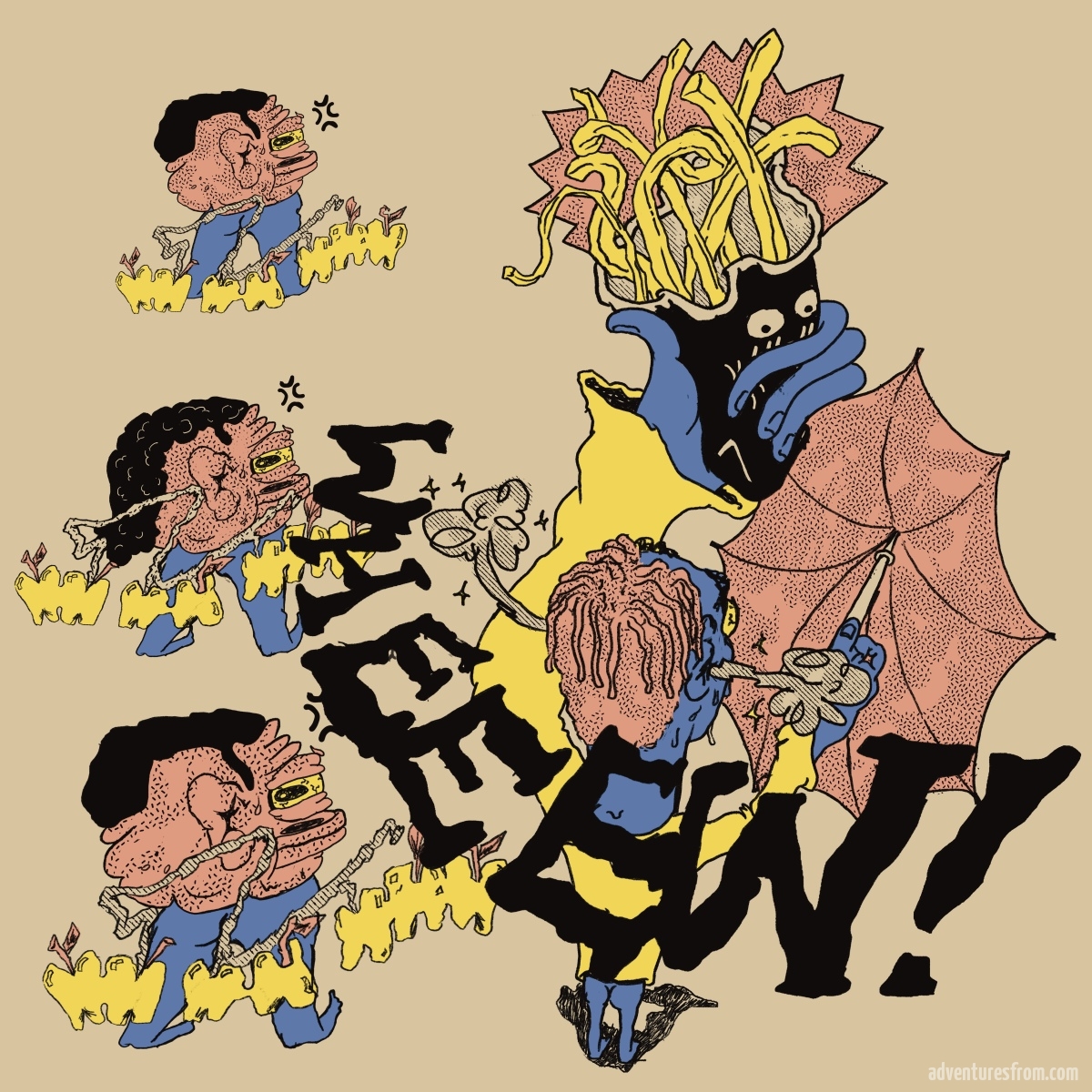
Drawing from the theme "Embracing Our Scars," this piece is a personal exploration of my journey growing up in a patriarchal, conservative home. It reflects my rebellion and feelings of disconnect, symbolised by an umbrella that creates a barrier between me and my parents. The fries illustrate the coping mechanisms I developed. The blue character represents both myself and anyone who can relate to this experience. Fumes and sweat emanate from the character, emphasising the physical and emotional strain. The text "Wheew" signifies a sigh of relief after deciding to disregard my parents' beliefs and expectations. The chain of apples not only refers to me being the "apple of my eye" to my parents showing irony in that those who love you can also be harmful to your development, it also showcases my enjoyment of drawing apples. This piece blends surrealism with humour to address serious themes in a lighthearted manner. The vibrant colours and unrealistic, cartoonish figures aim to make the subject matter more approachable and engaging. This piece draws on personal experiences but aims to resonate with a broader audience. Creating this piece allowed me to process and visualise my struggles and triumphs. The use of surrealism and humour helped me to present these themes in a way that feels true to my artistic style while making the message more accessible to viewers.

Inspired by the retro games and comic books from my childhood, Bizarre Odyssey portrays the journey through life's challenges and growth. The piece illustrates a "boss" and elements one encounters while navigating life's scars, including an orb which serves as reward for perseverance, growth and maturity. Reflecting on my childhood, I used water and platform elements to symbolise the indirect and challenging journey of life. The chair signifies schooling and the vulnerability of childhood, while the fire represents various trials faced along the way. The mushroom-like figure embodies the friendships and communities formed throughout this journey. The spider-like figure, being crushed by a car, represents the final boss—symbolising my scars, authority figures I have rebelled against, and unfair societal ideologies. This scene captures the confrontation of these obstacles, the outcome is unclear as life is still going on. Bizarre Odyssey is a visual metaphor for the trials, scars, and growth experienced in life. It combines elements of childhood nostalgia with deeper themes of resilience and maturity. Making this piece was a journey in itself, allowing me to reflect on my past and the scars that have shaped me. The use of retro game and comic book aesthetics adds a personal touch, making the serious themes more relatable and visually engaging.
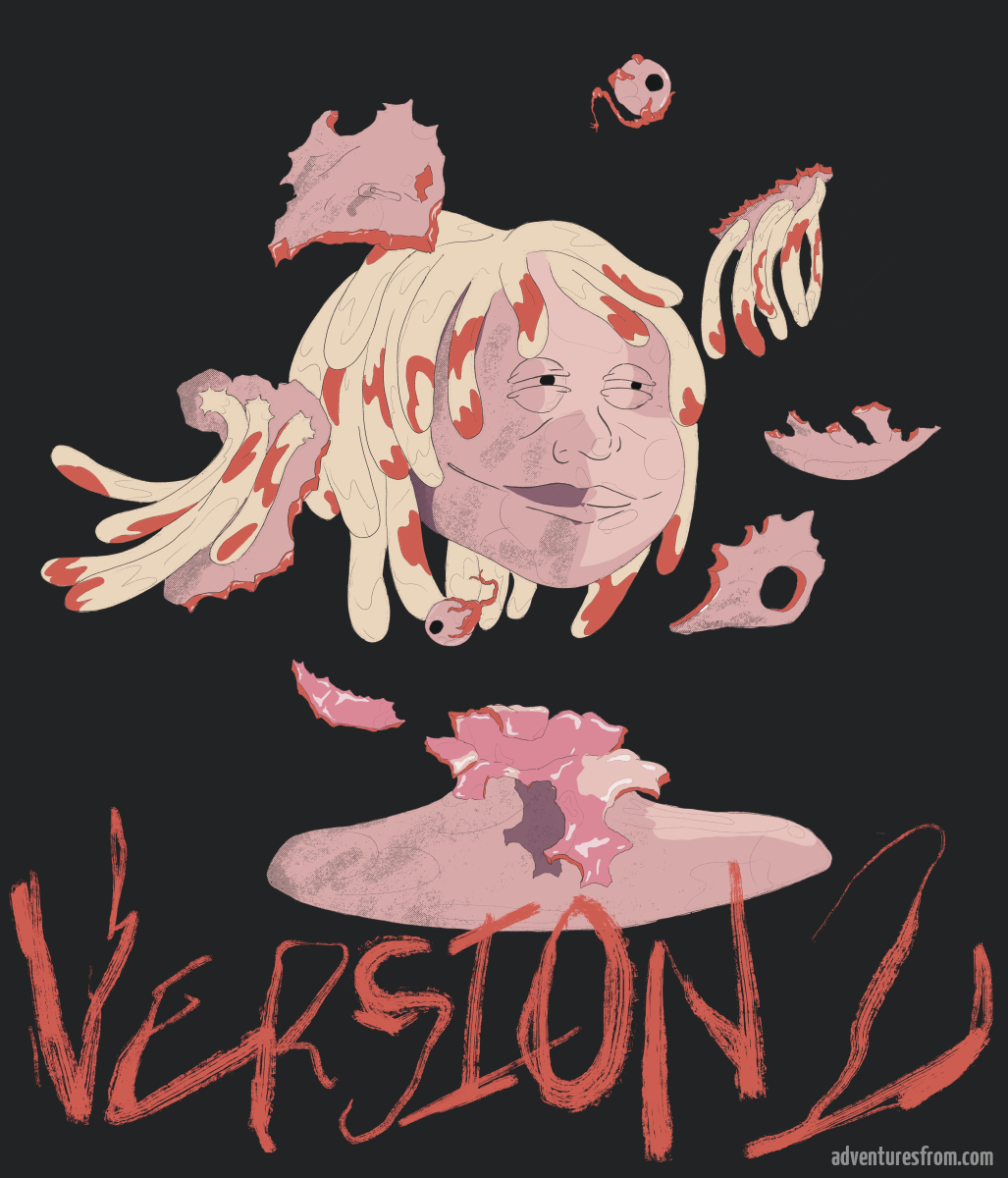
Version 2 illustrates a new version of self emerging from the old. This piece captures the process of healing—painful, difficult, and uncomfortable—yet ultimately leading to the formation of a stronger self. It also symbolises the continual potential for redefining and reinventing ourselves, regardless of the scars we carry. This artwork depicts the old version of the character bursting, while a new, more resilient version bursts forth. The visual metaphor of transformation emphasises the idea that healing and growth often come from enduring and overcoming challenges. Version 2 highlights the cyclical nature of personal evolution. It suggests that despite the pain and difficulty of healing, these experiences forge a stronger, more resilient identity. The piece encourages viewers to see their scars as markers of growth and the ability to continually reinvent themselves. The style, inspired by surrealism, blends emotional depth with striking visuals.
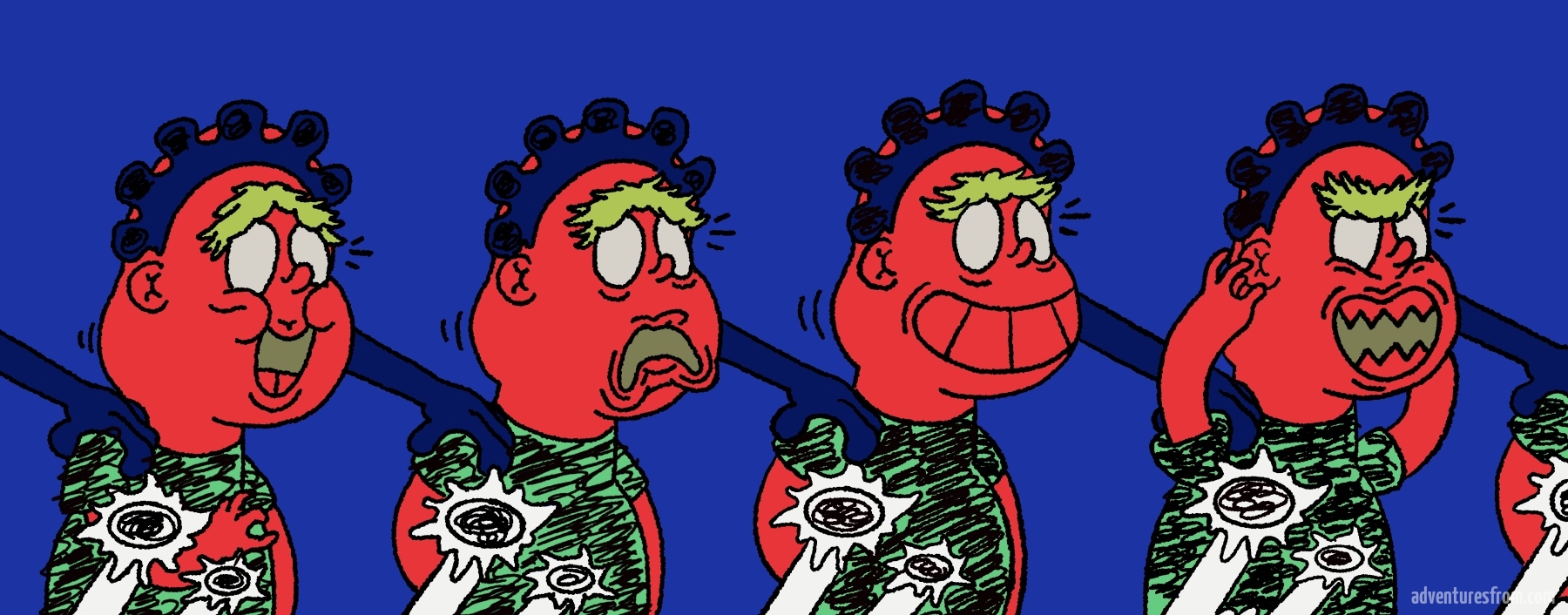
In Seasons I explore the various states and emotions that define the human experience—including joy, excitement, fear, anxiety, nervousness, anger, and pride. This piece captures the idea of embracing the different "seasons" we go through, reflecting the fluidity of our emotions and the different versions of ourselves that emerge over time. The hand on the characters symbolise support, representing the connections and guidance we receive as we navigate these emotional shifts. The artwork is intentionally cut off on the left and right sides, symbolising the continuous evolution of our emotional states and the potential for new feelings and experiences to arise. The cartoony style and use of primary and complementary colors infuse the piece with a laid-back, humorous, and playful energy. This approach lightens the exploration of complex emotions, making the artwork exciting and engaging. The character embodies the different emotional "seasons" we all experience. Seasons encourages viewers to embrace the full spectrum of their emotions, recognizing that each state is a natural and valuable part of life. The playful and colourful style underscores the idea that even the most challenging emotions can be approached with a sense of humour and acceptance.
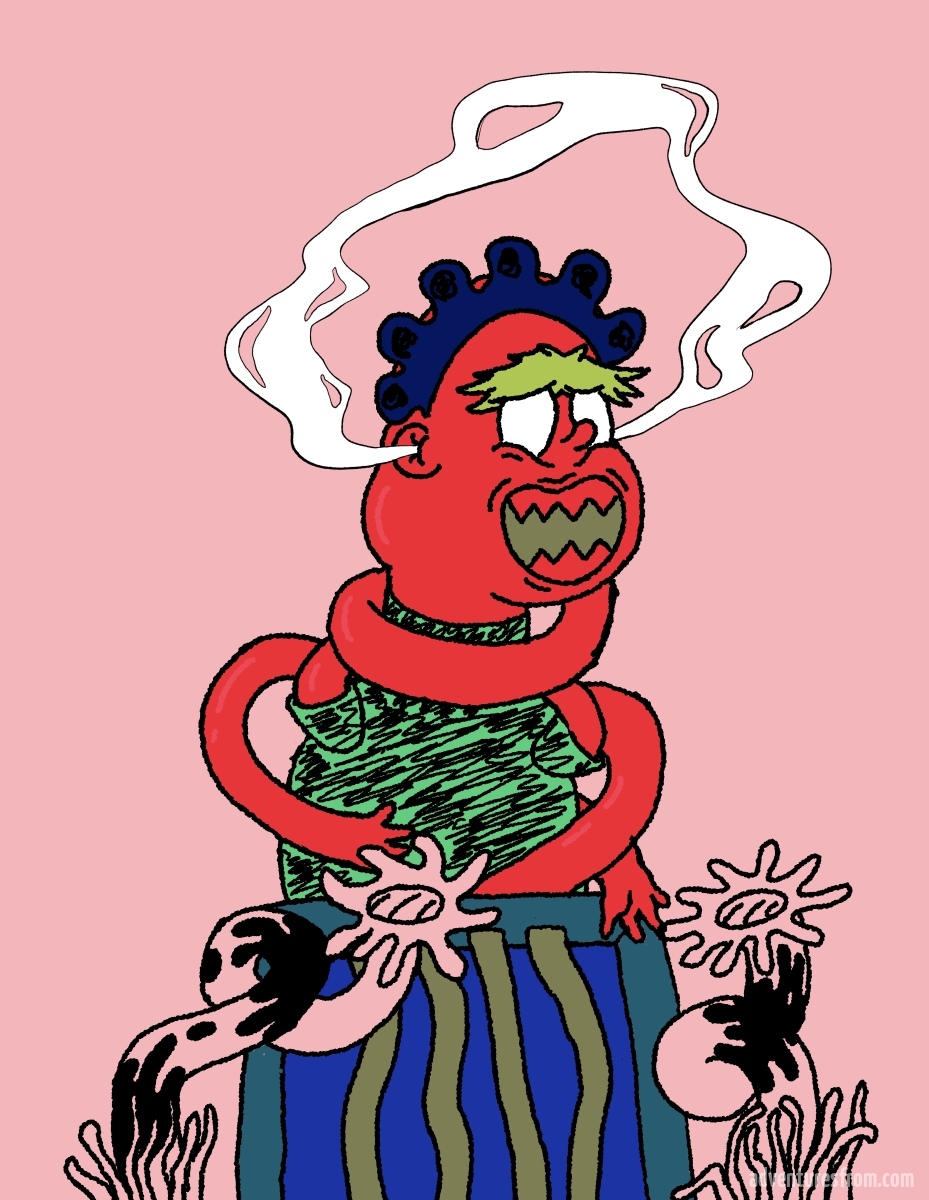
Self Infliction draws from my journey as an artist, exploring different fields both within and outside of art, as well as delving into my identity, dreams, and community. The piece represents the complexities of self-exploration, where the process of discovery can be both exhilarating and overwhelming. The twisted, tangled hands symbolise the exploration of various paths and possibilities, reflecting the confusion and stress that often accompany such choices. This imagery also highlights how internalised anxieties and beliefs can lead to self-inflicted pressure. The character's hands, though tangled, are open to interpretation, embodying the normalcy of confusion, backtracking, and the pursuit of multiple directions. The recurring illustration of flowers represents hope, positivity, and growth, offering a counterbalance to the chaotic and tangled hands. The jail at the bottom of the character symbolises self-entrapment—the way we sometimes confine ourselves to specific identities or paths, thereby blocking other possibilities. Smoke fumes rising from the character represent anxiety, anger, confusion, bravado, and burnout, capturing the emotional turmoil that can accompany self-discovery. Self infliction explores the tension between self-exploration and self-imposed limitations. It encourages viewers to reflect on their own journeys, recognizing the value in confusion and the importance of staying open to new paths and identities.
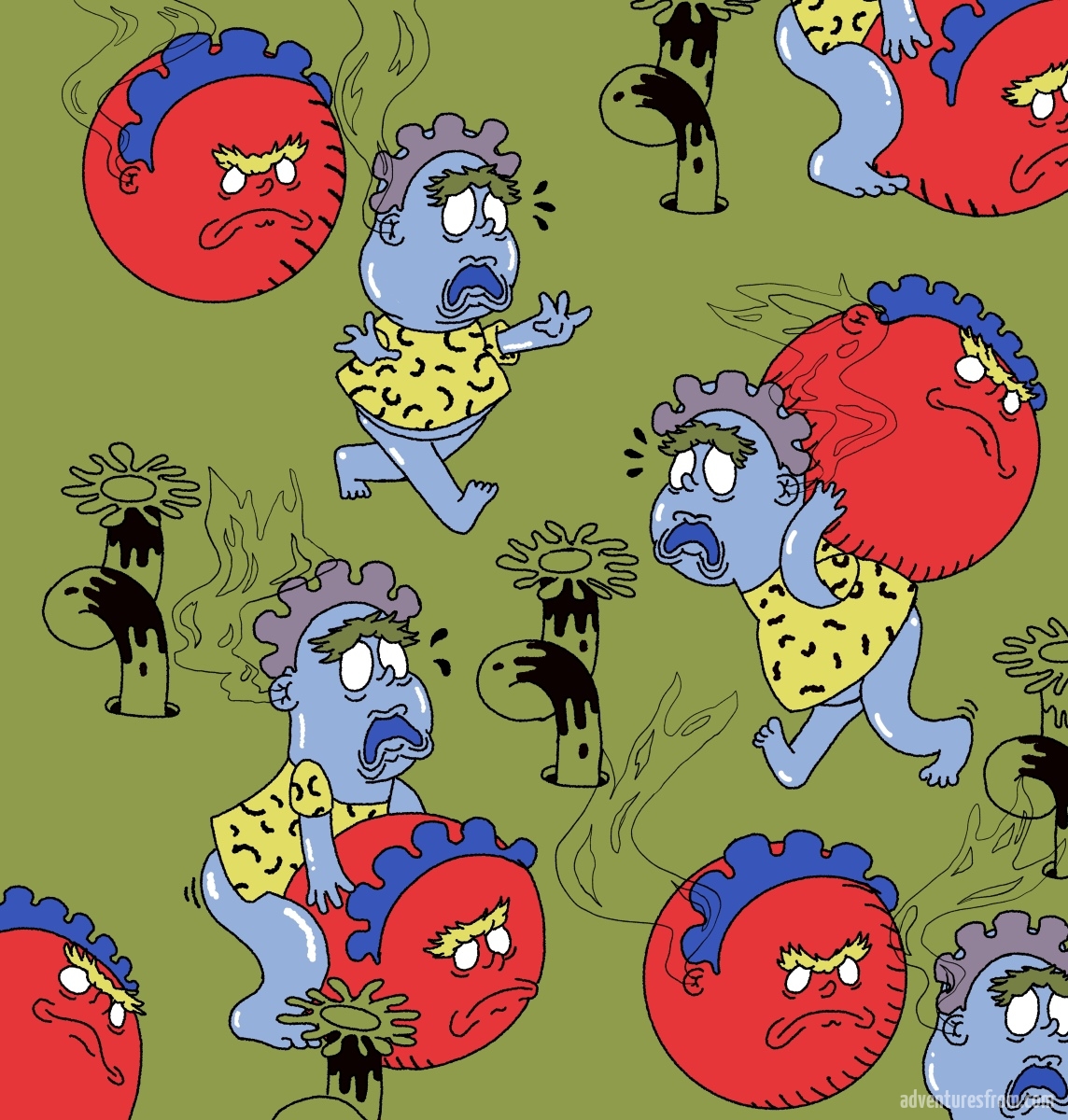
Dead Weight draws inspiration from the idea that we often stand in our own way. The piece features a blue and red character who are one and the same, symbolising the internal conflict between our true selves and the anxieties and worries that burden us. The blue character, distressed and half-naked to represent vulnerability, is seen carrying or trying to escape the menacing red head that symbolises its own fears. The red head, much larger in size, represents the character’s stresses and anxieties, with its colour and frowning expression amplifying its menacing presence. Despite being tortured by the red head, the character is yet to realise that this entity is a part of itself. The inclusion of flowers in the scene represents growth and life, offering a contrast to the stress and painting a hopeful picture amidst the chaos. The cartoony style, with exaggerated features and bold colours, balances the heavy themes of burden, anxiety, and self-imposed obstacles. The oversized red head represents the overwhelming nature of these internal struggles, while the smoke fumes symbolise anxiety. The piece serves as a reminder that much of what we fear is self-created, and that these anxieties may not reflect reality. Dead Weight is a visual metaphor for the ways we allow our worries and overthinking to hinder our progress. The piece encourages viewers to recognize and confront these self-imposed barriers, promoting self-awareness and growth.

